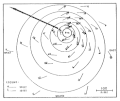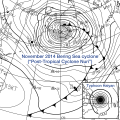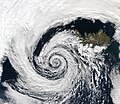Portal:Tropical cyclones
The Tropical Cyclones Portal
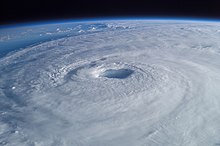
A tropical cyclone is a storm system characterized by a large low-pressure center, a closed low-level circulation and a spiral arrangement of numerous thunderstorms that produce strong winds and heavy rainfall. Tropical cyclones feed on the heat released when moist air rises, resulting in condensation of water vapor contained in the moist air. They are fueled by a different heat mechanism than other cyclonic windstorms such as Nor'easters, European windstorms and polar lows, leading to their classification as "warm core" storm systems. Most tropical cyclones originate in the doldrums, approximately ten degrees from the Equator.
The term "tropical" refers to both the geographic origin of these systems, which form almost exclusively in tropical regions of the globe, as well as to their formation in maritime tropical air masses. The term "cyclone" refers to such storms' cyclonic nature, with anticlockwise rotation in the Northern Hemisphere and clockwise rotation in the Southern Hemisphere. Depending on its location and intensity, a tropical cyclone may be referred to by names such as "hurricane", "typhoon", "tropical storm", "cyclonic storm", "tropical depression" or simply "cyclone".
Types of cyclone: 1. A "Typhoon" is a tropical cyclone located in the North-west Pacific Ocean which has the most cyclonic activity and storms occur year-round. 2. A "Hurricane" is also a tropical cyclone located at the North Atlantic Ocean or North-east Pacific Ocean which have an average storm activity and storms typically form between May 15 and November 30. 3. A "Cyclone" is a tropical cyclone that occurs in the South Pacific and Indian Oceans.
Selected named cyclone -
Severe Tropical Cyclone Gene was the deadliest storm as well as the most damaging tropical cyclone of the 2007–08 South Pacific cyclone season east of 160ºE. RSMC Nadi monitored Gene as the 12th tropical disturbance, as well as the fourth tropical cyclone and the third severe tropical cyclone to form west of 160ºE during the 2007–08 South Pacific cyclone season. Gene was also recognised by RSMC Nadi as the fifth tropical cyclone and fourth severe tropical cyclone to form within the South Pacific Ocean during the 2007-08 season.
On January 25, a tropical disturbance formed within the Fijian Archipelago and was designated as Tropical Disturbance 12F. The next day it was upgraded to a tropical depression, whilst on January 27, RSMC Nadi named the depression as Cyclone Gene. Later that day Gene made landfall on Fiji, and caused 8 deaths and $51 million (2008, F$). Cyclone Gene then slowly intensified to a category three cyclone on both the Saffir–Simpson hurricane scale and the Australian Cyclone Intensity Scale. Gene then took a turn to the south moving towards 25°S which marks the edge of RSMC Nadi's area of responsibility with the Tropical Cyclone Warning Centre (TCWC) in Wellington, New Zealand. Gene then crossed 25°S on February 3 and Nadi released their final advisory. Cyclone Gene continued as a Tropical Cyclone for three days before becoming an extratropical cyclone. Early on February 6 TCWC Wellington released their final advisory on tropical cyclone Gene as they declared it as extratropical. (Full article...)
Selected article -
The 1990 Andhra Pradesh cyclone was the worst disaster to affect Southern India since the 1977 Andhra Pradesh cyclone. The system was first noted as a depression on 4 May 1990, while it was located over the Bay of Bengal about 600 km (375 mi) to the southeast of Chennai, India. During the next day the depression intensified into a cyclonic storm and started to intensify rapidly, becoming a super cyclonic storm early on 8 May. The cyclone weakened slightly before it made landfall on India about 300 km (190 mi) to the north of Madras in the Andhra Pradesh state as a very severe cyclonic storm with winds of 165 km/h (105 mph). While over land the cyclone gradually dissipated. The cyclone had a severe impact on India, with over 967 people reported to have been killed. Over 100,000 animals also died in the cyclone with the total cost of damages to crops estimated at over $600 million (1990 USD). (Full article...)
Selected image -

Selected season -

The 2003 Pacific hurricane season was the first season to feature no major hurricanes (storms of Category 3 intensity or higher on the Saffir–Simpson hurricane wind scale) since 1977. The season officially began on May 15, 2003 in the Eastern North Pacific (east of 140°W), and on June 1 in the Central (between 140°W and the International Date Line); both ended on November 30. These dates, adopted by convention, historically describe the period in each year when most tropical cyclogenesis occurs in these regions of the Pacific. The season featured 16 tropical storms, 7 of which intensified into hurricanes, which was then considered an average season. Damage across the basin reached US$129 million, and 23 people were killed by the storms.
Despite the overall lack of activity, the season produced an unusually large number of tropical cyclones that affected Mexico, with eight tropical cyclones making landfall on either side of Mexico, which was the second highest on record. Tropical Storm Carlos struck Oaxaca in late June, resulting in nine fatalities. In late August, Hurricane Ignacio struck the Baja California Peninsula, killing four people and inflicting US$21 million in damage. In September, Hurricane Marty affected the same areas as Ignacio, and was responsible for 12 casualties and US$100 million in damage, making Marty the costliest and deadliest storm of the season. In October, Hurricanes Olaf and Nora struck western Mexico as tropical depressions, causing slight damage and one casualty. (Full article...)
Related portals
Currently active tropical cyclones

Italicized basins are unofficial.
- West Pacific (2024)
- No active systems
- North Indian Ocean (2024)
- No active systems
- Mediterranean (2024–25)
- No active systems
- South-West Indian Ocean (2024–25)
- No active systems
- Australian region (2024–25)
- No active systems
- South Pacific (2024–25)
- No active systems
- South Atlantic (2024–25)
- No active systems
Last updated: 22:26, 6 November 2024 (UTC)
Tropical cyclone anniversaries

November 5
- 1991 - Tropical Storm Thelma (pictured) made landfall on Samar in the Philippines. Thelma killed around 6,000 people throughout the Philippines.

November 6
- 1988 - Typhoon Skip reached its peak intensity with 230 km/h (145 mph) winds just to the east of the Philippines. Skip made landfall soon after that, killing about 100 people.
- 1996 - A powerful cyclone (pictured) made landfall over Andhra Pradesh in southeastern India, killing 1,077 people, with total damages amounting to $602 million.
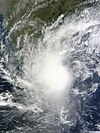
November 7
- 1984 - Hurricane Klaus made landfall in extreme eastern Puerto Rico shortly before it reached its peak intensity. Klaus brought heavy rain to the island, exceeding 635 mm (25 in) at Guavate Camp.
- 1994 - Hurricane Florence reaches peak strength as a Category 2.
- 2010 - Cyclone Jal (pictured) makes landfall near Tamil Nadu causing about $1.73 billion of damages.
Did you know…
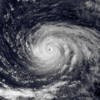



- …that the Joint Typhoon Warning Center considers that Typhoon Vera (pictured) of 1986 is actually two distinct systems, formed from two separated low-level circulations?
- …that Cyclone Freddy (track pictured) in 2023 was the longest-lasting tropical cyclone worldwide?
- …that Cyclone Raquel (track pictured) travelled between the Australian and South Pacific basins between the 2014–15 and 2015–16 seasons, spanning both seasons in both basins?
- …that Hurricane Otis (pictured) in 2023 was the first Pacific hurricane to make landfall at Category 5 intensity and surpassed Hurricane Patricia as the strongest landfalling Pacific hurricane on record?
General images -

The 2020 Atlantic hurricane season was the most active Atlantic hurricane season on record in terms of number of named storms. Additionally, it was an above-average season for tropical cyclones for the fifth consecutive year. The season officially began on June 1, 2020, and ended on November 30, 2020. These dates, adopted by convention, historically delimit the period each year when most Atlantic tropical systems form. However, storm formation is possible at any time of the year, as was the case this season, when its first two named storms, Tropical Storm Arthur and Tropical Storm Bertha, formed on May 16 and May 27, respectively. The final storm, Hurricane Iota, dissipated on November 18.
Altogether, the season produced 31 tropical or subtropical cyclones, all but one of which became a named storm. Of the 30 named storms, 14 became hurricanes, and seven further intensified into major hurricanes. It was the second and final season to use the Greek letter storm naming system, the first being 2005. Hurricane Laura produced catastrophic storm surge levels, heavy rainfall, and spawned over a dozen tornadoes after striking Louisiana on August 27 with winds of 150 mph (240 km/h). The storm was responsible for 81 deaths and it caused over US$19 billion in damage across the Greater Antilles and the Southern United States. Causing significant late-season loss of life and widespread destruction were November hurricanes Eta and Iota, which made landfall in Central America as Category 4 storms just two weeks apart. The storms left a toll of 184 deaths and 110 missing across the region, and thousands of families lost their homes and livelihoods. In March 2021, the names Laura, Eta and Iota were retired from reuse in the North Atlantic by the World Meteorological Organization due to the extraordinary amount of damage and number of fatalities they caused. (Full article...)
Topics
Subcategories
Related WikiProjects
WikiProject Tropical cyclones is the central point of coordination for Wikipedia's coverage of tropical cyclones. Feel free to help!
WikiProject Weather is the main center point of coordination for Wikipedia's coverage of meteorology in general, and the parent project of WikiProject Tropical cyclones. Three other branches of WikiProject Weather in particular share significant overlaps with WikiProject Tropical cyclones:
- The Non-tropical storms task force coordinates most of Wikipedia's coverage on extratropical cyclones, which tropical cyclones often transition into near the end of their lifespan.
- The Floods task force takes on the scope of flooding events all over the world, with rainfall from tropical cyclones a significant factor in many of them.
- WikiProject Severe weather documents the effects of extreme weather such as tornadoes, which landfalling tropical cyclones can produce.
Things you can do
 |
Here are some tasks awaiting attention:
|
Wikimedia
The following Wikimedia Foundation sister projects provide more on this subject:
-
Commons
Free media repository -
Wikibooks
Free textbooks and manuals -
Wikidata
Free knowledge base -
Wikinews
Free-content news -
Wikiquote
Collection of quotations -
Wikisource
Free-content library -
Wikiversity
Free learning tools -
Wikivoyage
Free travel guide -
Wiktionary
Dictionary and thesaurus

























